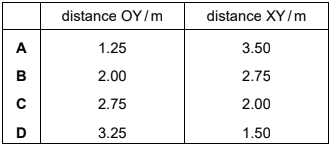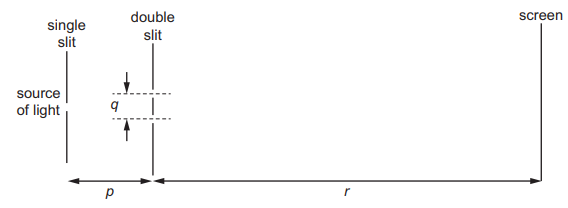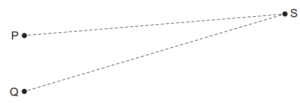Question
Two loudspeakers X and Y emit sound waves that are in phase and of wavelength 0.75 m.
An observer O is able to stand anywhere on a straight line that passes through X and Y, as shown. The observer stands at a point where the sound waves from X and Y meet in phase.

What could be the distances OY and XY?

Answer/Explanation
Ans:
Question
Light of wavelength λ is incident normally on two narrow slits S1 and S2, a small distance apart. Bright and dark fringes are observed on a screen a long distance away from the slits.

The n th dark fringe from the central bright fringe is observed at point P on the screen.
Which equation is correct for all positive values of n?
A \(S_{2}P-S_{1}P=\frac{n\lambda }{2}\)
B \(S_{2}P-S_{1}P=\frac{n\lambda }{2}\)
C \(S_{2}P-S_{1}P=(n-\frac{1}{2})\lambda \)
D \(S_{2}P-S_{1}P=(n+\frac{1}{2})\lambda \)
Answer/Explanation
Ans:
Question
A teacher sets up the apparatus shown to demonstrate a double-slit interference pattern on a
screen.

Which change to the apparatus will increase the fringe spacing?
A decrease the distance p
B decrease the distance q
C decrease the distance r
D decrease the wavelength of the light
Answer/Explanation
Ans:
Question
Two loudspeakers are placed near to each other and facing in the same direction.
A microphone connected to an oscilloscope is moved along a line some distance away from the
loudspeakers, as shown.
Which statement about the waves emitted by the loudspeakers is not a necessary condition for
the microphone to detect a fixed point along the line where there is no sound?
A The waves must be emitted in phase.
B The waves must be emitted with a similar amplitude.
C The waves must have the same frequency.
D The waves must have the same wavelength.
Answer/Explanation
Question
Two sources of microwaves P and Q produce coherent waves with a phase difference of 180°.
The waves have the same wavelength λ.

At the point S there is a minimum in the interference pattern produced by waves from the two
sources. The distance (QS – PS) is called the path difference.
Which expression could represent the path difference?
Answer/Explanation
Ans
